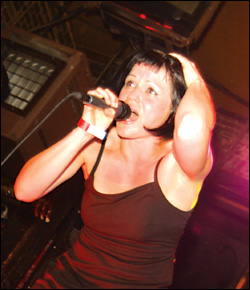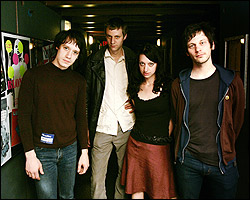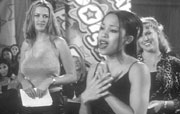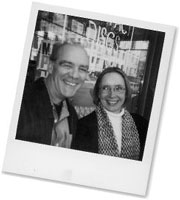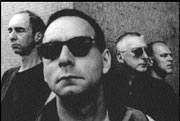Guitarist Dave Dayton has placed a lot of Musician Wanted ads. Singer Bre Loughlin has answered more than her fair share. After years of composing queries and circling them with bright markers, Kuma’s two principal songwriters finally found each other—and what they were looking for—a few years ago. Though it took until February of 2003 before they cemented the band and had their first show, Dayton and Loughlin knew very early on that the Gods of Alternative Weekly Want Ads had finally smiled on them.
Bound by a shared affinity for the likes of Massive Attack, Björk, Love and Rockets, and Jane’s Addiction—as well as a desire to explore electronics and emotion— Dayton, Laughlin, programmer and keyboard player Corey Paganucci, and guitarist Neal Hallmark use their band as a means of communication. When they heard they had been nominated as Best New Artist, Dayton and Loughlin were pleased, not least because the category is the only one that includes the word “art.” Although a fan posted the adroit suggestion “romantic industrial” to their Web site message board, they say they really have no idea how to label their sound—artistic conversation is the primary goal.
“I love the expression that is permitted in this music,” says Loughlin. Kuma work fiercely and collaboratively—a member brings in a song, or a piece of a song, and the band discusses the music until the color, mood, and direction of the emotions or story behind the sounds are understood. Songs only come together after everyone knows what it is they’re trying to convey with each element. The expression must be consistent with the intent. It sounds exhausting. It also sounds really medicinal, and I half-jokingly suggest that their cathartic, analytic process must render therapy unnecessary.
“Oh no, we still need therapists,” says Dayton, also half-joking.
But it’s clear that a lot has been sacrificed for the sake of Kuma and their chosen methodology. Laughlin walked away from a career as an RN and gave up her spot in the Stuck-Ups—just before the pop/punk band set off to tour Europe, no less. Yet you can’t talk to her about Kuma’s music, or see her perform, without sensing that she has absolutely no regrets.
Kuma use programmed beats—not static drum-machine patterns but complex, orchestrated rhythms—and effects-heavy live instruments as a lush backdrop for Loughlin’s vocal gymnastics. A lighting designer, Randall Ross of Teatro ZinZanni, is considered an integral part of the band. Because she cascades through a three- octave range and employs goth-toned atmospherics and theatrical flair, fans usually assume that Loughlin’s primary influences are Siouxsie Sioux and Kate Bush, rather than her real heroes, Annie Lennox and Sinéad O’Connor. In the song “Bottled Dreams” from Kuma’s self-released EP, The Moment of Silence Before the Disaster, Loughlin breathily exudes impatience and need before the band breaks into a fuzzed wall of glitches and white-noise guitars. The music shares headspace with bands like My Bloody Valentine and Portishead, and Kuma feel allied with local acts like Sushirobo, Post Stardom Depression, and the Dead Science, but Dayton says the band is caught somewhere in between.
“We know what we’re doing is not cool in Seattle right now,” he says. “We like what’s around the corner. We like what we can’t see.”
